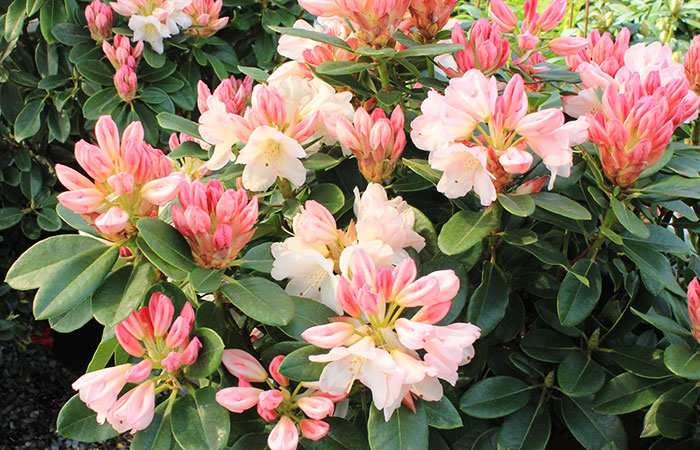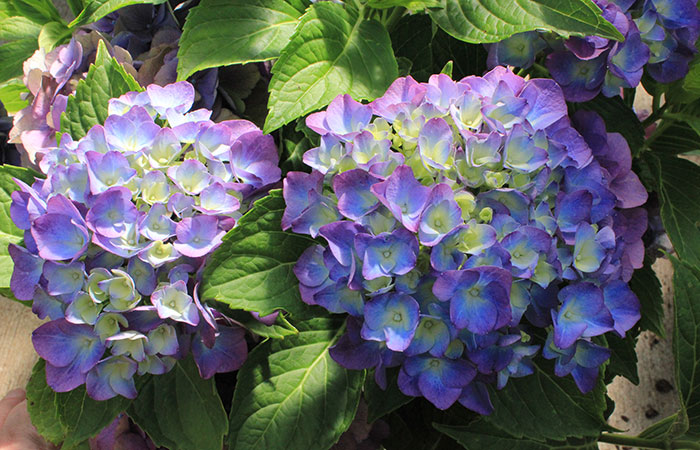Soil Acidity in the PNW
Have you heard that you need to “sweeten” your soil, that you should check your soil pH, or that your soil might be too acidic? Many gardeners have heard about soil acidity or soil pH, but not many of us really understand what it means.
It’s an important topic. No matter what else you do, the acidity of your soil can make or break your garden’s success. That’s because soil acidity plays a huge role in how well your plants can get at the nutrients they need.
Learning about soil acidity can seem daunting. But we hope this will be a gardener-friendly overview, no chemistry PhD required. Even a very basic understanding can help us all identify problems more accurately and improve our gardening skills.

Rhododendrons, native plants in our area, flourish in acidic soil

Hydrangea varieties that change color w/ soil pH turn brilliant shades of blue in PNW Soil.
How does soil acidity affect plants?
Just like our bodies have certain conditions in our surroundings that keep us comfortable and healthy — not too hot or too cold, not too humid or too dry — so do plants. Most plants like soil that is just slightly acidic. They have a narrow range that’s best for them. Outside of that range, their lives become more difficult no matter how hard a gardener might try to help them.
The more acidic the soil is, the more easily minerals and plant nutrients dissolve in water. Since plant roots can only slurp up nutrients that are dissolved, this has a big impact on your plants. More dissolved nutrients can help plants out in moderation, but it can easily go too far.
When soil is too acidic, a whole lot of minerals end up dissolved in the water your plants rely on. In very acidic conditions, these minerals can get so concentrated that they become toxic. They can also be toxic to the soil microbes that break down organic matter and help your plants thrive. High concentrations of dissolved minerals make other nutrients harder for your plants to access too.
It’s much less common in the Pacific Northwest, but soils can also be not acidic enough. The opposite of acidic is alkaline. In soils that are too alkaline, it’s hard for plants to access the minerals they need, no matter how much fertilizer a gardener might add.
The take-home message is: it’s all about balance. Plants thrive best within their optimum pH range, which is usually just a teeny-tiny bit acidic.
"Just like our bodies have certain conditions in our surroundings that keep us comfortable and healthy — not too hot or too cold, not too humid or too dry — so do plants."
Ok, but what is soil acidity?
We’ll keep the chemistry brief. If you’re curious, there’s enough information out there to last a lifetime. But we’ll stick to what we think gardeners most need to know.
Acidity and its opposite, alkalinity, have to do with hydrogen ions floating around in a solution. It is measured using pH, which is all about how many hydrogen ions that aren’t attached to molecules are floating around. The “H” stands for hydrogen, the “p” represents a whole math thing.
The pH scale goes from 0 to 14. On this scale, 7 is considered neutral. Anything lower than 7 is acidic, and anything higher than 7 is alkaline. For reference, lemon juice is rather acidic at a pH of about 2.5, and baking soda is moderately alkaline at a pH of about 8.5.
The optimum pH for most plants in our gardens is 6 to 7. When we say soil is “too acidic,” we generally mean it has a pH lower than 6. In areas that have alkaline soils — again, usually not in our region — the pH is above 7.

What is PNW soil like?
Here in the Pacific Northwest, our soils naturally run a bit on the acidic side. Due to the rocks our soils come from and the amount of rain we get, soils in our region usually have a pH of about 5-6. This is great for northwest native plants like Pacific rhododendrons and red flowering currants. It’s also good for a few other plants like azaleas and blueberries.
But vegetables and many popular non-native ornamental plants will struggle in our naturally acidic soils. We need to help them out so that they can thrive here.
"Soils in our region usually have a pH of about 5-6."
What do I do about it?
If you want to make sure your soil has the optimal pH for the plants you want to grow, the first step is to find out what you’re starting with.
You have a few options here. You can buy single-use pH test kits or reusable pH meters here at Sky and get a pretty good estimate the DIY way. Or, you can send your soil in to a professional testing service. Regardless, you’ll want to make sure you test several samples at several different times, since a single test is just a snapshot of an ever-changing situation.
If your tests show that your soil averages around a pH of 6-7, you’re in good shape for growing vegetables, herbs, and most ornamental plants. You don’t need to do anything about your soil pH besides check it again the following year to make sure it hasn’t dropped below 6.
If your soil is closer to a pH of 5-6, your next step depends on what you want to grow. That’s a perfect range for native plants and blueberries, but a bit too acidic for most garden plants and vegetables.
If your pH is even lower than 5, your soil might have been damaged in the past. Very acidic soil is usually caused by over-application of synthetic fertilizers. It might take some time for your soil to recover, but you can help it recover by holding off on synthetic fertilizers, gradually applying ground limestone and adding compost. You may want to consider gardening in containers in the meantime.
If you’d like to raise your soil’s pH, the quickest and easiest way is to add ground limestone. Use it sparingly, following the directions that you’ll find on the package. More renewable alternatives like wood ash and oyster shells can also help raise soil pH, but the effects are harder to predict. Make sure you start with just a little, give it time before adding more, and continue to check the pH of your soil as you go.

PNW Native soils usually have a pH of 5-6.
This is perfect for acid loving blueberry plants!
"If you’d like to raise your soil’s pH, the quickest and easiest way is to add ground limestone. Use it sparingly.."
Remember that pH is just one part of soil health. No matter what actions you might take to change the acidity of your soil, make sure that you’re also practicing overall good soil care by adding plenty of compost, using organic fertilizers as needed, and protecting your soil from the elements with a healthy layer of mulch.
In the end, healthy soil is about maintaining a balanced ecosystem over the long term. Small changes to soil pH over time are natural, so don’t stress about them too much. Just focus on keeping your soil generally within a range that is healthy for your plants, and adjust your soil gradually as needed to keep everything on track.
